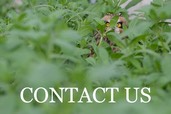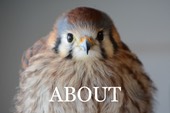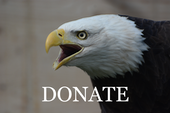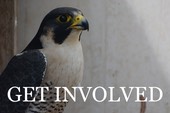Golden Eagle 16-437
At approximately four months of age, Golden Eagle 16-437 has led a harrowing life. One of three siblings, as documented by eagle falconers Joe and Cordi Atkinson who rescued the starving eagle, he grew up in the high desert of eastern Oregon in what can only be described as a pretty rough neighborhood. His nest/home was located on the face of a high cliff. Neighbors included a family of Prairie Falcons. From the crease on the top of his head, 16-437 appears to have strayed a little to close to their nest, on what may have been his maiden flight, and been strafed by one of the adult Prairie Falcons.

16-437’s blood lead level is 6.2 micrograms/deciliter, indicating his parents have already unintentionally exposed him to lead by feeding him prey that has been shot with lead ammunition. It is impossible to know the effects of low levels of lead in raptors, but that amount of lead has been well documented to cause irreversible damage in young children. Lead negatively impacts decision making and learning ability, critically important skills in a young eagle.
16-437 also has a badly damaged foot with two broken toes. We always try to determine how our patients have been injured. Often times we can only speculate, as in the case of this young eagle. His injuries are consistent with having been caught in a leg-hold trap, which raises additional questions. If he was caught in a trap, the trap would have been improperly set so that it attracted an eagle. If he was caught in a trap, someone would have had to release him from the trap. That is virtually the only way he could have gotten free from the trap and still have his toes intact. We will likely never know for sure how he was injured.


We can, however, treat the conditions that we see. His wounds were cleaned and his right foot was immobilized with a splint form-fitted to his foot.

An intravenous catheter was placed in his right wing to make it easier to treat his dehydration and emaciation. It takes at least three days to replace the fluid deficit in an extremely dehydrated bird. The first two days 16-437 received all his fluids via the catheter to ensure they were immediately available to his system. The catheter has a short extension attached to it, allowing the eagle to be treated in an upright position (much less stressful than being placed on his back on the treatment table).

16-437 weighed 2.1 kilograms on admission, approximately 40% below the average weight of a male Golden Eagle. The first day-and-a-half he had no interest in food. By the evening of the second day he tentatively accepted a few bites of quail. By day three he was beginning to show some enthusiasm for food. We will take several more days to reintroduce him to a normal amount of food to ensure that his gut has recovered from the effects of starvation and is functioning properly.
Tri-Cities Transport Volunteers Needed
16-437 was one of 20 raptors and 63 patients admitted the past week. Blue Mountain Wildlife has an awesome network of transport volunteers, but we need more in the Tri-Cities area. If you can be available one or two days a week or one or two days a month, please contact Toni at 509-948-8065. Thank you in advance for your willingness to help wildlife in distress.
Two More Gunshot Birds
A fledgling Red-tailed Hawk was found near Grandview, WA. A radiograph showed its fractured radius and ulna were caused by a pellet from an air rifle. The damage to the wing was not repairable and the hawk was euthanized.

A Common Raven was found within the city limits of Baker City, OR. A radiograph revealed that the bird had been shot with a shotgun. The injury was at least a week old and not repairable. The Raven was euthanized.

Abnormal Feathers In Two Fledgling Red-tailed Hawks
Two Red-tailed Hawks were admitted on the same day with abnormal feather development. One hawk came from Chelan, WA, the other from Walla Walla, WA. The feathers appeared to be pinching off. The cause of the condition is unknown, but the birds will be tested for West Nile Virus.

Another Red-tailed Hawk Mystery
A young Red-tailed Hawk was admitted from the Yakima area with virtually all its feathers coated in a gummy substance. Mineral oil and Dawn Dish Soap were ineffective in dissolving the goo.








